Buildings
About
More than a few years ago (2011 to be exact), I wrote a post about historic detached carports and included some designs of our own that we thought would be fun to build and useful in a variety of situations. Like many of my random design exercises, none of the sketches were built, until now. And I must say that it looks even better in real life than in my head.
A customer in the oldest city in the US, St. Augustine contacted us and was interested in replacing a rather rickety open garage behind her new-to-her 1920s bungalow. We started with some garage designs, but didn't find the right solution until we dusted off the carport/ shed sketches and found something that fit both the site and the customer's needs.










We are now offering plans for the Carport Shed for sale online for the DIYer or those not located in Florida: Carport Shed Construction Plans
Historic Shed recently was able to put its mark on our own Hernando County by building a new 8'x8' parking attendant shed for the Pine Island Beach Park. While Hernando County is located directly on the Gulf of Mexico, there are few public beaches, with Pine Island Park offering the only sandy Gulf beach. Therefore our little shack will be seen by many residents and visitors to Hernando County, particularly as Florida winter weather attracts northerners in the next couple of months. The island history is important in Hernando County history and some interesting background on the island and surrounding area can be read here in the Hernando Sun.

The Gulf is very shallow off Hernando County and while Pine Island is beautiful, it is more a wading beach than a swimming beach.

The birds really like the beach at Pine Island. I take a photo of the footprint patterns nearly every time I go there.

Here are some of the beach footprint makers: Black Skimmers
The small shed was placed on a concrete slab and the interior will be finished out by the county. The layout allows the parking attendant to take in the parking fee, while enjoying cool air from a ClimateRight 5000 BTU unit. The vibrant colors were chosen by County staff, who clearly had a really good time making their choices. The colors will compliment a new fence and playground equipment that are part of the overall park upgrades.

The shed's vibrant colors now greet all visitors to the park. The cypress shutters are operable and allow the windows to be secured after hours and during storms. Hooks hold them open so that breezes won't slam them shut.

Flood vents are located on two sides of the shed as it is located within a flood zone.

Shutters closed and latched. This is what shutters are designed to do.

The batten shutters really make a nice accent on the shed, as well as being functional.
We design a lot of custom sheds that complement historic bungalows, but most are commonly covered with lap or novelty siding. Recently we got a chance to built a slightly differently clad shed for a unique 1940s bungalow in New Port Richey. The house, and an existing garage on the lot are both covered completely in wood shingles, so we designed the new shed accordingly.

The cedar shingles made the shop smell so good!

Walls up and roof dried in.
-800x572.jpg)
The shed is designed for use as a workshop with a small door for every day use and a large one for bigger items. The windows on the side are double-hung, meaning that the top slides down and the bottom slides up.
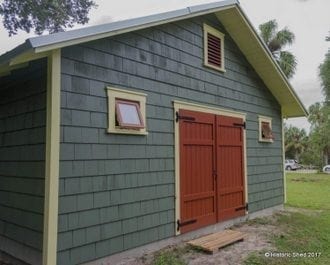
The front gable elevation has a vent that matches the main house.

Shed details showing 1x6 roof sheathing, cedar shingle siding, awning windows and traditional trim.

The shed nestled in the yard.
We are often asked if we can provide just a building shell that the owner can then finish out on their own. The answer is, of course, "Yes!" We don't often get to see the end results, but one of our historic homeowner customers recently sent us some photos showing how wonderful his new space is.
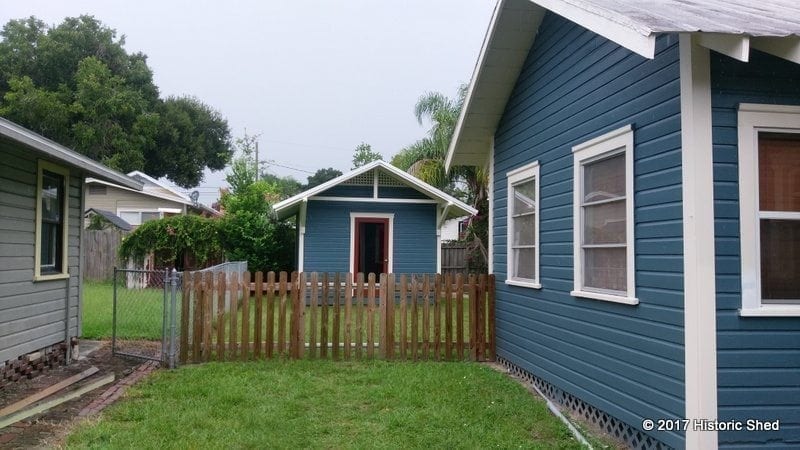
The 12'x16' shed was designed to complement the main house in the East Lake Morton Historic District in Lakeland.

The shed seen shortly after Historic Shed finished installation.

The homeowner built a wood deck in front of the shed and made it look "oh so homey".

The cozy inside features a futon sofa and a 3/4 bath behind the louvered doors.

The interior also has a storage shelf at the gable ends and a small kitchenette.

The 3/4 bath.
One of our customer favorites is the tropical Snack Shack that we built in Palm Harbor with combination bar and storage shed. The shed design was recently adapted for a narrow site behind a historic Craftsman style home in the Old Seminole Heights Neighborhood in Tampa. The resulting shed was 8'x18' version with framing details that complemented the historic home. The shed was approved by the local historic preservation office.

Details from the main house that drove the shed design
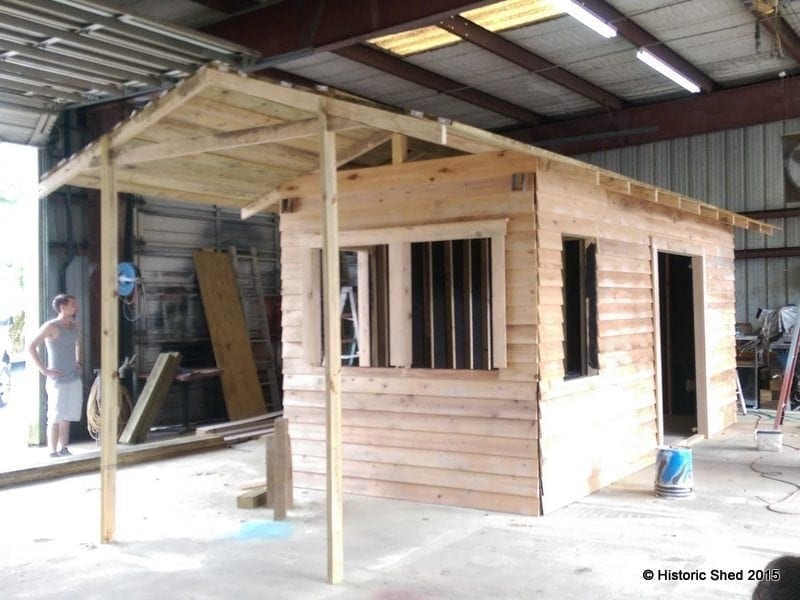
Building the shed at the Historic Shed shop

Installation of the Craftsman Snack Shack shed on site

Bar interior

Ventilation door between the pub and storage areas

Awning doors locked down
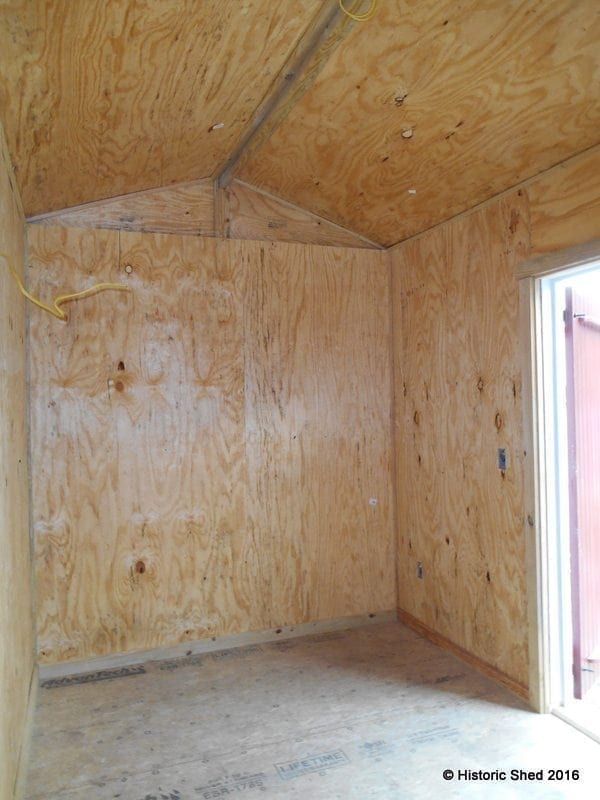
Interior of the storage shed area
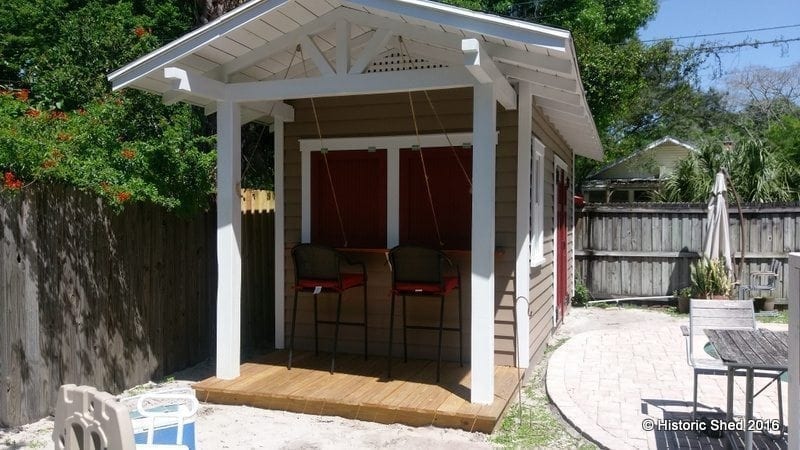
The finished shed with awnings closed

Pulleys that open the bar doors

The shed sits nicely by the pool
One of the perks of being in the preservation business is seeing all sorts of great historic sites that aren't always available to the public. When we worked primarily as historic preservation consultants under our Preservation Resource, Inc. mantle, we got to crawl in attics and private rooms of house museums, disused hotels, and even airplane hangers. Now, as we focus on making outbuildings for historic neighborhoods, we get to see private homes that aren't open to the public (I never say no when invited inside for a moment). One of the recent highlights was seeing a high-style Craftsman style bungalow in the Old Northeast neighborhood in St. Petersburg that was under rehabilitation.

The house has heavy timber framing details, great clinker brick porch piers, wide eaves and long, low lines.
Known as the Sargent House, 806 18th Avenue NE was recently designated as a historic landmark by its newest owners, Sharon Winters and Kendall Reid. Originally built in 1923 by LeRoy and Marjorie Sargent, the house is significant for its architecture as a rare example of higher-style Craftsman design and construction in the airplane bungalow type. (See the full report at: http://www.stpete.org/committee%20packets/Community%20Planning%20and%20Preservation%20Commission/2016-04-12%20Reports.pdf). A local landmark designation recognizes structures or places that have historic value or that exemplify cultural, economic, or social value to the city, state, or nation. The benefits of this designation include neighborhood stabilization, increased heritage tourism through the maintenance of our historic character, relief from some of the requirements of the Florida Building Code, and an ad valorem tax exemption.
Historic Shed was hired to design and build a small storage shed to be placed behind the house. The simple shed incorporated elements from the house such as the gable detailing, roof pitch, and outrigger design.

The shed is located within a flood zone and has flood vents along the back and alley side.

The roof outriggers are prominent on the main house. The shed has scaled down versions to visually complement the main house. The gable vents are also geometrically similar.

While the main house is covered in shingles, the shed uses cypress siding. The doors reflect the Craftsman design of the main house.

The shed nestled behind the main house
Some home details are just so lovely they just have to be replicated. For this 10'x12' shed that Historic Shed built in the historic Duckpond Neighborhood in Gainesville, Florida, the eave brackets and unique gable vents were replicated to create a one of a kind shed. The result is a main house and shed that harmonize very well. The shed design was reviewed and approved by the local historic preservation office.
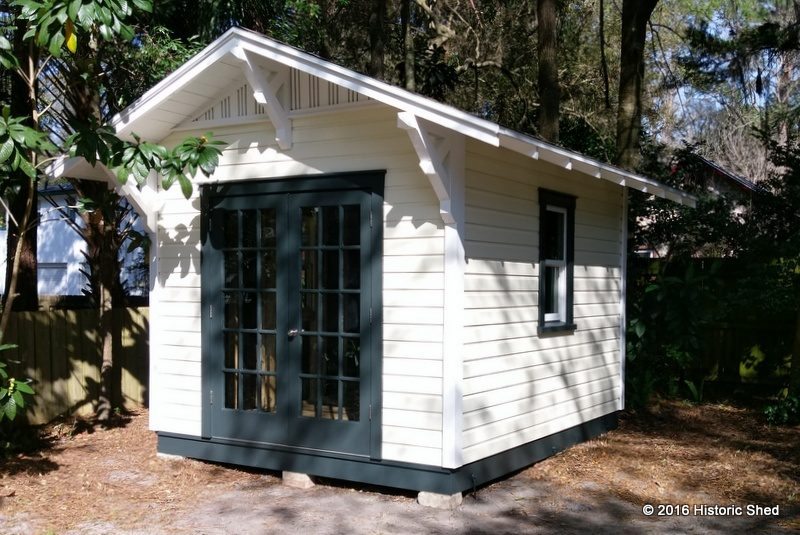
10'x12' custom shed with French doors and interesting eave brackets

Shed vent detail complements the main house

Craftsman eave brackets being prepped for for a Historic Shed storage shed

Historic Shed installation

The original Craftsman bracket detail on the historic Duckpond house

The existing gable vent on the historic home - note the different outrigger detail on this side of the house
Every time we are approached by an artist in need of a studio, we end up with a unique shed design that is worthy of showing off. In this case, a local artist in Citrus County requested a fairly large 14'x16' shed with lots of windows. The design has great balance, is filled with light and looks lovely with a great set of accent French doors. It will serve as a great "She Shed" for the owner.

This clasic shed is accented nicely with a fun colored set of French doors.

The front elevation has nice symmetry.

The shed has a nice bank of three windows on the left side.

The rear of the shed has two operable transom windows, allowing light, but also wall space inside.

Retractable screen doors were installed behind the French doors to give protection from bugs but not taking up interior floor space.

The interior walls were insulated and tongue and groove pine installed.

The finished interior has exposed roof framing with board sheathing and pine T & G walls with simple trim.

The finished interior looking out.

The interior after some fun creative moments - photo courtesy the Owner.

Ready to move in - photo courtesy the Owner.

And a beautiful view of the shed in the yard, courtesy the Owner.
Historic Shed™ recently completed a lovely flamingo pink shed set by a pool in a well landscaped backyard in Dania Beach. The shed had SmartSide smooth lap siding, cypress trim, 4x4 eave brackets, JeldWen double-hung wood windows, and a pair of French doors.

The tropical color contrasts nicely with the relaxing blue of the pool

A pair of French doors makes an inviting elevation

The shed helps frame in the outdoor kitchen and seating area

The shed from above
Last summer we built a shed in the historic Village of Longboat on Longboat Key, which was the talk of the neighborhood according to our customers. The home where the shed was built is the oldest building on the island, built in 1902 and was originally an Inn and Restaurant. The shed we built for them used elements of the main building, including novelty wood siding and a metal roof. It was the first one we built with a transom over the shed doors, which turned out to be a really nice architectural feature.
The shed was set to the rear of the main building, along the side yard with access to the rear alley. It was set far enough from the side property line to allow storage of kayaks and other equipment, so the owners had the concrete pad extended to the side.
The shed had a very steep roof, gable vent that complemented the main house, and a double set of doors that faced the rear alley.
The side of the shed has a central doors flanked by two 6/1 windows. There are also flood vents since the area is located in a flood zone.
About 9 months after completing the shed, we were contacted by a neighbor in Longboat Key who also lived in a historic home. His home was originally the one-room school house for the village, which had been transformed into a residence in the 1950s. He liked the neighbor's shed just the way it was, so asked for something similar, using elements that complemented his home.
The Village of Longboat Key has an interesting history and is worth a walk around if you are heading to the beach in that area (which is definitely worth visiting as well). For a walking tour, see: http://www.longboatkeyhistory.com/tour-route--history.html and http://www.longboatkeyhistory.com/map--details-of-tour-route.html. As you walk around, keep an eye out for the roaming peacocks, which add a nice eccentric touch to the area.
We have found that Florida artists love our Historic Shed outbuildings for studios. Inspired by the Sunny Artist Studio Shed, an artist in Sarasota contacted us to build a similarly styled shed for their back yard painting studio.

Their gable studio shed is 12'x12' and has a 4' front porch extension supported by large brackets. As always, artists pick great and unique color schemes that enhance our sheds. These colors look spectacular in person!

The shed features a double set of wood 10-light French doors and Jeld Wen double-hung wood windows on each side. The angled placement of the shed in the corner of the yard makes it a focal point from all vantage points.

The owners placed wooden letters in the wet concrete for a fun entrance into the shed.

Wood planks were installed over insulation to finish off the walls. The roof framing and sheathing were left exposed for a rustic look with extra height.

Looking into the empty shed, ready to move in.

After Historic Shed completed their installation, the owners installed landscaping. (Photo courtesy of the owner)

Double French doors at the end of the new path make for an inviting studio full of light and fresh air. (Photo courtesy of the owner)

The shed interior finished and ready for inspiration. (Photo courtesy of the owner)
Last year we were delighted to be contacted by a couple with this email note:
My husband & and I have been stalking your site for a year, waiting until our yard was ready to get a shed. I think we're close! We are in downtown Orlando, have a 1911 colonial revival/farmhouse.
We knew we'd like them instantly.
They live in the lovely Lake Eola Heights Historic District in Orlando, located within walking distance to downtown Orlando. The houses were built primarily between 1890 and 1925 and have an amazing array of styles and detail. Theirs was full of texture and character.
They didn't need an overlarge shed, but it needed character and lots of windows. And to be a test case for the colors they planned to paint their house. Because the property is located within a designated historic district, the shed design was reviewed by the local historic preservation office. 

Installing the Lake Eola Shed

Double French doors let in lots of light. Gable shingles mimic those on the main house.

The shed has a metal roof to match the one on the main house porch.

Casement windows let in ample light.
A couple of months after we were done, we received this lovely email note with the photo below:
Just wanted to let you know how happy we are!! We don't have much in the ground yet- but the veggies are happy- waiting on electric & water to go in, then the brick paths- then garden beds will be better defined. We have spent more time in the back yard in the past few months than we have in 3 years!

This lovely 10'x10' shed was delivered to Fruitland Park, Florida, a beautiful area with many lakes. The owner had a newer stucco over block home, but wanted a shed with a little traditional Craftsman flair for the yard.

Custom 10'x10' Craftsman Style Shed by Historic Shed
The shed is set on a wood deck, strapped down into concrete, cypress siding, and a 5-V crimp metal galvanized roof. The shed has Craftsman style eave brackets, a 3/1 double hung window, and Craftsman styling on the 4' wide beadboard shed door. It is accented nicely by the owner's classic color choices. After it was installed, we received this lovely email from the owner:
"Glenn and I couldn't be more pleased with our new garden shed. Craig spent a lot of time 'tweaking' and the pride he takes in his product is now obvious. Again, we are very pleased and have started to 'move in' today. Thank you for being so attentive to the finishing. Will send pictures when we're done installing walkway, plants, etc. Your sheds need to be featured in home and garden magazines....they are unique!"

Craftsman Shed with 4' wide cypress beadboard door
When a local artist called Historic Shed for her new art studio, she knew exactly what she wanted. She'd been saving our ad from a magazine for several years and had sketched up all her ideas in her notebook. We built her a 12' x 12' shed with paired French doors on three sides. A 4' roof extension on the front is supported by large brackets, providing shelter for her doors and a seating area. The shed has a metal roof and cypress siding.

The owner says she opens the doors on all three sides to get a nice breeze and lots of light.

The owner installed shelves along the back wall (the only one with no doors or windows). A mini-split AC system is located at the peak of the wall, allowing lots of storage below. A sink was installed at the right end of the counter after these photos were taken.

The interior was finished with drywall but the roof framing and sheathing were left exposed.

The three pairs of French doors allow ample light in the room.

The lovely landscaping provides a nice view from inside the shed.

A set of wheels make a mobile surface from her work table.
A flash back to construction below: the exterior shell took 3 days to put up. After the electrical and AC unit was installed, Historic Shed finished out the shed interior with drywall and cypress trim. The roof framing and sheathing was left exposed for and open look.

The concrete slab ready for the shed delivery.

The owner had etched the slab entry porch as it was setting up to create a really special detail.

The shed starting to come together.

We had a crowd excited to see the shed go up.


Isn't it cute?

Ready for creativity.
The City of Ormond Beach, Florida proudly titles itself the "Birthplace of Speed" with a long history of auto racing that started in 1902 on the hard packed beach sand when automobiles were new and existing roads were poor.

Racers lined up on Ormond Beach, courtesy the Florida State Archives
After the Winton Bullet won a Challenge Cup against the Olds Pirate by a breathtaking two-tenths of a second in 1903, Ormond Beach established itself as the ideal proving ground for automobile designers and racing aficionados from around the world. Motorcycle and automobile owners and drivers brought vehicles powered by gasoline, steam and electric engines, sometimes cruising at over 100 miles per hour along the ocean side. You can see actual race footage on the beach from 1905 on YouTube at Ormond Beach Florida Auto Races.

On January 26, 1906, F.E. Stanley’s Rocket Racer, driven by dare-devil Fred Marriott, set the mark that became Ormond Beach’s most famous land speed record. The incredible speed record of 127.659 mph held for four years - Image courtesy the Florida State Archives
While autos may still drive along the beach, beach racing is now only commemorated at Birthplace of Speed Park, located on A1A at the intersection of SR40. The park has a series of markers telling the story of racing and provide wonderful views of the ocean.

View of the ocean from Birthplace of Speed Park in Ormond Beach. What an amazing place to work!

Glenn Hammond Curtiss set a land speed record of 136.4 mph on his motorcycle on Ormond Beach in 1907. Other markers are located around the park.
The park used to showcase two replicas of the two history-changing racers, the Winton Bullet and the Olds Pirate, but the ocean climate made maintaining the cars difficult and they were removed for repairs. Members of the Motor Racing Heritage Association decided that it would be ideal to bring back another piece of Ormond Beach racing history and place it in the park to protect the replica cars.
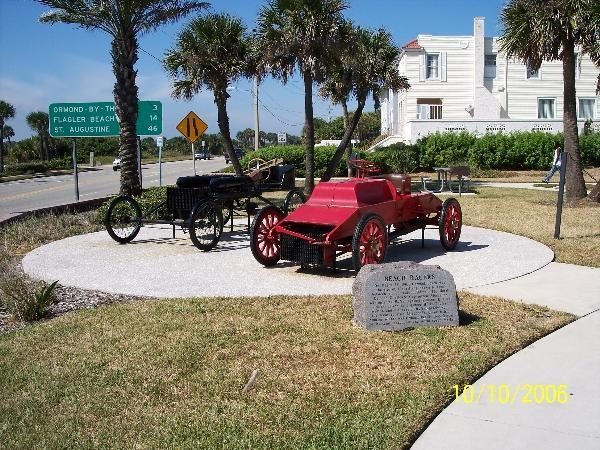
The replica cars that were on display in the park.
The Ormond Garage was built in 1904 by Henry Flagler, railroad magnate and owner of the Ormond Hotel, to accommodate participating race cars during the beach races (and to keep them away from the front of his hotel). The large garage housed the drivers and mechanics during the speed time trials, while the owners and manufacturers stayed at the hotel.

The Ormond Garage stayed the center of racing for many years, later storing antique cars and racing memorabilia, but unfortunately burned down in 1976.
While much larger than could be accommodated within the park, the old garage was to serve as design inspiration for a new structure to house and protect the replica race cars in Birthplace of Speed Park. The Motor Racing Heritage Association began fund raising in order to build the garage, and came to Historic Shed to discuss the project. After a few design iterations to make the project more affordable, and a couple of years of fund raising, the project was officially launched at the end of 2012. Last week, the interior was completed and the first of the replica cars will move in shortly.

Installation of the new garage building in Birthplace of Speed Park by Historic Shed.

The garage was hand-lettered by Spike Signs giving it the perfect accent and reference to the original garage.

Marker in front of the new garage telling the history of the two replica cars.

The garage was dedicated on March 28th, 2013, 110 years after the race that made the beach world famous.

A sign was posted on the side of the garage about the project and its supporters. The sign is shaped like one that decorated the original garage. Other memorabilia saved from the historic garage will be added to the new garage.

The finished garage sits nicely with the existing marker for an accent.

The new Ormond Garage pays homage to the original in a scaled down version

The garage interior was finished with grooved cedar boards.

The Olds Pirate replica inside the garage

The new Ormond Garage in its park setting.
This very fun project would not have been the same without Suzanne Heddy, Director of the Ormond Beach Historical Society and Motor Racing Heritage Association Treasurer; Ron Piasecki, President of the Motor Racing Heritage Association, Inc.; and Dan Smith, Hometown News writer and Motor Racing Heritage Association's "Go To Guy" and the numerous other racing history fans in the area. We offer so many thanks for their direction, entertainment and support!
Some more info on the garage project and racing history can be found at these links:
A tribute to the famous Ormond Garage 1904-1976
Ormond Garage replica going up in Speed Park
City’s heritage on display with new replica garage
Green shed marks auto racing's starting line
The History of Speed in Ormond Beach